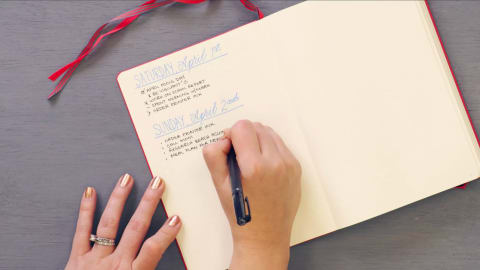Advertisement
How To Finally Start A Bullet Journal & Declutter Your Overloaded Brain


If you've been looking for a way to get organized and, let's be honest, produce some good social media content in the process, you've undoubtedly heard about bullet journaling—the oddly beautiful system of organizing your thoughts, goals, and to-do's in a notebook according to an almost scientific system.
If you're unfamiliar with the BuJo method (as the cool kids call it), it can initially seem super overwhelming and complicated. But it doesn't have to be. And, as you'll soon learn, it's highly customizable.
Here, we break down what exactly a bullet journal is and why it's beneficial, what supplies you'll need to get started, and how to organize it and customize it to meet your needs.
What is a bullet journal?
Bullet journaling is an analog organizational system developed by designer Ryder Carroll in 2013, requiring nothing more than an empty notebook and a pen. The purpose: to track the past, organize the present, and plan for the future. "I needed a system flexible enough to handle whatever I threw at it and fast enough that it wouldn't get in the way," Ryder explains in his bullet journaling tutorial.
But what does this flexible system actually consist of? The building blocks (or sections) of a bullet journal are known as modules. These modules include a future log for big-picture or long-term planning, a monthly log that's sort of like a calendar with shorter-term tasks and goals, and a daily log for more immediate stuff. In the very beginning of your bullet journal, you create an index page that ties everything together so you can easily find what you need.
Compared to other planners or calendars with a finite amount of space for each day and no real sections for "random thoughts," a bullet journal is a great depository for anything that might pop into your head.
What are the benefits of bullet journaling?
It organizes your thoughts and gets them out of your head.
If you're the kind of person who has a million ideas and to-do's running around you head, a bullet journal can help you get them all out on paper. There, they'll feel much more tangible and approachable, as opposed to overwhelming and out of control. Once they're in front of you, you can figure out what you want to prioritize.
It's as budget friendly as you need it to be.
All you really need to bullet journal is a notebook and writing device. Other cost-friendly supplies could include some markers and a little washi tape, but really—the practice can be as cheap as you need it to be.
It helps you keep track of your goals.
Bullet journaling can help you keep track of your goals and essential tasks. Once these are written down, you'll have a streamlined record of your action plan. And even if things get pushed back, that's the beauty of the modules; you can always move tasks around.
It's completely customizable.
While traditionally just used for logging future, monthly, and daily goals and tasks, there's no shortage of things you can include in a bullet journal. Books you want to read, movies you want to watch, your go-to grocery list, and habit trackers are just a things you can add to its pages.
Bullet journal supplies.
- Leuchtturm1917 A5 Dot Grid Notebook: This notebook is the perfect size for carrying around with you on a daily basis. The dot grid helps to keep all of your tasks and to-do's organized.
- Sharpie Art Pens: These felt-tip pens are ideal for daily logs and writing in your bullet journal. They dry quickly, do not smear, and last longer than many options out there.
- Paper Mate Flair Pens: These pens are great for adding colorful headers and divider lines in your bullet journal. Bonus: They won't bleed through your pages!
- Paper Mate InkJoy Gel Pens: These are great for those who prefer a traditional "ballpoint" feel. The InkJoy Gels are super-smooth writers and dry within seconds—again, without any smear or bleed through.
How to start and set up a bullet journal.

You have a broad overview of what a bullet journal consists of, but now let's get into the nitty-gritty of how to set up and organize your bullet journal. In addition to using this as your guide, we highly recommend watching the official bullet journal video tutorial and consulting the Bullet Journal website for insider tips straight from the source.
Number your pages.
If your notebook isn't already numbered, be sure to add a page number in the bottom corner of each page. This will help you out when you create your index.
Create an index.
Leave a few pages blank at the beginning of your notebook for your index. The index is where all of your bullet journal entries will eventually get organized. As you start to use your notebook, add the topics of your entries and their page numbers to the index, so you can easily find them later.
Create your logs.
Logs the most crucial components of a bullet journal, where you organize your thoughts, to-do's, events, projects, and future goals.
Future log
The future log is where you write down any events that will occur in the months ahead such as birthdays, holidays, trips, meetings, and more. These should be things that are important but that don't need to be on your immediate radar just yet. Take a look at some examples of future logs here. As you'll notice, many people devote two spreads of their notebook to their future log for the year. Each spread is then divided into six sections (for a total of 12 sections), and in each section, you'll write down the month and events for that month.
Monthly log
Following your future log comes your first monthly log. The monthly log is where you'll be keeping track of all your current month's events, appointments, and tasks. The monthly log can be set up in a matter of minutes. Benz highly recommends waiting until the day before the month begins to create your monthly log since you never know how much space the rest of the current month will need.
Devote one notebook spread to your monthly log. Write down your dates and days of the week down the left-hand side and fill in any upcoming events and appointments that you know about at the beginning of the month. Then, as the month unfolds, you can log any little tidbits of things that happened each day, as well as add additional appointments as they come up. The right-hand side of the spread is for your monthly tasks and goals. These don't need to be in any particular order. Take a look at some examples of monthly logs here.
Daily log
After the monthly log spread come the daily log pages for that particular month. The daily logs or "dailies" are where the bullet journal system comes alive, and they likely resemble your current daily to-do lists. To create a daily log, write down the date at the top of the page. Then, over the course of the day, "rapid log" your various tasks, events, and notes as they occur. If you don't fill a page, simply start the next day's log right below it. Take a look at some creative examples of daily logs here.
The daily log is also where the use of various symbols called signifiers comes into play to categorize each item on your list and assign it a level of importance. As you get comfortable bullet journaling, you can create custom signifiers:
- Tasks are signified by a dot or bullet point (•) for actionable items and to-do's. When a task is completed, mark it with an X.
- Events are signified by an open circle (ο) for date-specific items.
- Notes are signified by a dash (-) for great ideas worth keeping.
- An asterisk (*) denotes priority or important tasks.
- An exclamation point (!) is for inspiration items.
- An eye is for items that need more research or information.
Create custom collections.
Collections can be lists, projects, or anything else that you want or need to insert into your bullet journal (e.g., ideas to de-stress, books you've been wanting to read, recipes you've been wanting to make, etc.). That's the beauty of the bullet journal system. Whenever you need to write something down, you can go to the next available page or space and get to writing. To organize your collections, it's as simple as writing them into your index so that you can easily find them later.
Watch Next
Enjoy some of our favorite clips from classes
Enjoy some of our favorite clips from classes
What Is Meditation?
Mindfulness/Spirituality | Light Watkins
Box Breathing
Mindfulness/Spirituality | Gwen Dittmar
What Breathwork Can Address
Mindfulness/Spirituality | Gwen Dittmar
The 8 Limbs of Yoga - What is Asana?
Yoga | Caley Alyssa
Two Standing Postures to Open Up Tight Hips
Yoga | Caley Alyssa
How Plants Can Optimize Athletic Performance
Nutrition | Rich Roll
What to Eat Before a Workout
Nutrition | Rich Roll
How Ayurveda Helps Us Navigate Modern Life
Nutrition | Sahara Rose
Messages About Love & Relationships
Love & Relationships | Esther Perel
Love Languages
Love & Relationships | Esther Perel

















